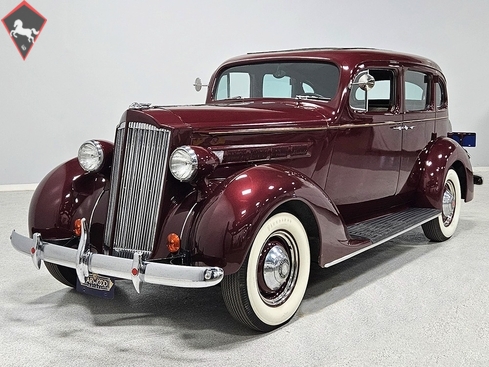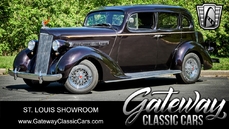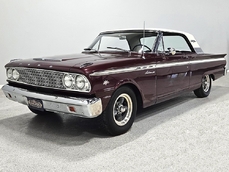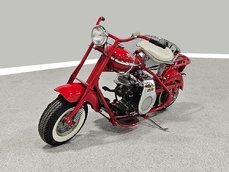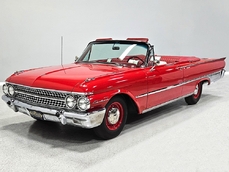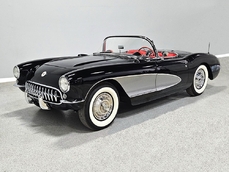Packard 115 237 cubic inch inline-6 1937
General description :
Attractive entry-level Packard. Great-running and torquey 237 cubic inch inline-6. 3-speed manual. Appealing color combination with extremely nice interior that was professionally restored. Packard quality at a Model A price!
Packard introduced the 8-cylinder 120 and the 6-cylinder 110/115 lines to stay alive during the Great Depression, but it’s no secret that the cars remained high-quality, albeit more affordable. The plan worked and the result is that there are Packards to fit all budgets today. This handsome 1937 Packard 115-C sedan shows you that a lower sticker price didn’t eliminate the intangibles that make Packards special. This car has doors that close with a solid THUNK, it has familiar styling that echoes the large series cars without looking cartoonish, and the traditional Packard grille is still out there leading the way. The restoration is probably at least 20 years old at this point, but it’s holding up well with some signs of use and age but nothing that we would consider problematic. There are a few amateurish touch-ups to the paint at the high-wear areas around the hood, but otherwise the handsome maroon metallic paint shines up nicely and looks appropriate for a late-30s luxury sedan. It’s probably not quite as nice as it looks in photos, but you won’t be ashamed to be seen driving this lovely 4-door. The chrome trim was surely restored at the same time and is holding up nicely, particularly the bumpers and grille which have a brilliant shine. A Packard of any kind still commands respect on the road and at shows.
The wonderful interior was expertly restored and remains in first-rate condition. This part of the restoration probably cost $10-15,000 all by itself, and it’s really impressive. Correct fabrics and patterns mean that it looks like 1937 all over again and there’s enough room behind the wheel even for taller drivers (the seat is adjustable). The instrument panel features woodgrained inserts with a big, round speedometer ahead of the driver and secondary gauges arrayed in the center. They all appear to be operational except the clock, and the car includes an optional factory AM radio which is sadly not working. The big steering wheel makes it easy to handle the 115 around town and beautiful chrome plated handles on the door are another nod to Packard’s upscale history. Aftermarket turn signals have been added, which is always a good idea, and hobbyists with a family will appreciate the surprisingly spacious back seat. There’s also a decent trunk that includes a full-sized spare tire and enough room for some luggage and touring supplies.
Just because the 115-C was smaller doesn’t mean it wasn’t 100% Packard. The well-engineered and bulletproof reliable 237 cubic inch inline-6 is big enough to make the kind of torque Packard buyers expected. In fact, it’s only 45 cubic inches smaller than the 8-cylinder 120. IT has a familiar look, wearing traditional olive green engine enamel, and the flathead design means that it’s easy to maintain and rugged. There’s a factory carburetor fed by an electric fuel pump (that means no vapor lock on hot days) and a giant radiator helps keep things cool. It looks right with the oil bath air cleaner on top and there are signs of recent work including tune-up parts. It does start easily and run quite nicely, although there’s a small exhaust leak at the manifold that sounds a little coarse, but it doesn’t affect how it goes down the road. The synchromesh transmission shifts cleanly and the 115 is happy to cruise at 55 MPH without much effort at all. By 1937, all Packards used an independent front suspension, so ride quality is excellent, and hydraulic brakes were standard equipment on the 115 so stopping power is quite good for the era. We don’t believe the body has ever been off the frame on this car, so it’s a little grungy underneath, but there’s no structural rust or holes in the floors, and you can see just how robust the 115 really is—look at that frame! The muffler looks like an NOS piece that sounds just right, and it sits on 16-inch steel wheels with hubcaps and trim rings, plus a set of 6.50-16 Firestone wide whites of indeterminate age.
Extras include an original owner’s manual, a shop manual, original jack, and some spare parts useful for touring.
The name “Packard” still resonates with enthusiasts today, but they don’t all have to be six-figure supercars. This handsome 115-C sedan proves that you can have just as much fun with a much smaller investment and the Packard quality shines through. This isn’t a perfect car, but it’s a great starter collectable for someone interested in the pre-war hobby, a car that’s ready to enjoy and that can be upgraded as time allows. Along the way, you’ll be having fun and experiencing why Packards have been a favorite of hobbyists from the very beginning of the hobby. Call today!
NOTE: This car is titled by engine number.
Harwood Motors always recommends and welcomes personal or professional inspections of any vehicle in our inventory prior to purchase.
1937 Packard 115 237 cubic inch inline-6 is listed for sale on ClassicDigest in Ohio by Harwood Motors for $19900.
Car Facts
Car type : Car Make : Packard Model : 115 Model Version : 237 cubic inch inline-6 Engine size : 0.0 Model Year : 1937 Sub type : Sedan Location : Ohio Vehicle Registration : Undefined
19900 $
People who viewed this Packard 115 also viewed similar Packard listed at ClassicDigest
Other cars listed for sale by this dealer
About Packard
Packard: A Comprehensive HistoryEarly Years and Foundation:
Founding: The Packard Motor Car Company was established in 1899 in Warren, Ohio, by James Ward Packard, William Doud Packard, and George Lewis Weiss.
Pioneering Luxury: Initially producing high-quality automobiles, Packard became synonymous with luxury, craftsmanship, and engineering excellence.
Notable Achievements and Contributions:
Packard Twin Six: Introduced in 1916, this V12-powered car established Packard as a premier luxury automobile brand.
Model Line Expansion: Packard expanded its lineup with various models, including sedans, coupes, convertibles, and limousines, catering to affluent customers seeking elegance and performance.
Engineering Innovations: The brand introduced several innovations, such as the first use of aluminum pistons, air conditioning, and the Ultramatic automatic transmission.
Ten Historically Significant Models with Technical Specifications:
Packard Twin Six (1916):
Engine: 7.3L V12 engine.
Performance: Around 85 horsepower.
Packard Eight (1930-1938):
Engine: Straight-8 engine with various displacements.
Performance: Ranged from 90 to over 130 horsepower.
Packard Super Eight (1939-1951):
Engine: Straight-8 engine.
Performance: Produced between 130 to 180 horsepower.
Packard One-Twenty (1935-1942):
Engine: Straight-8 engine.
Performance: Approximately 100 to 120 horsepower.
Packard Clipper (1941-1957):
Engine: V8 engine.
Performance: Ranging from 135 to 185 horsepower.
Packard Caribbean (1953-1956):
Engine: V8 engine.
Performance: Varying between 275 to 310 horsepower.
Packard Patrician (1951-1956):
Engine: Inline-8 and V8 engines.
Performance: Ranged from 150 to 180 horsepower.
Packard Hawk (1958):
Engine: V8 engine.
Performance: Produced around 275 horsepower.
Packard Executive (1956-1958):
Engine: V8 engine.
Performance: Varying between 240 to 290 horsepower.
Packard Predictor (1956):
Engine: Concept car showcasing design and technology.
Performance: Prototype model.
Legacy and Influence:
Quality and Elegance: Packard was revered for its exceptional build quality, refined styling, and luxury features, often considered on par with European luxury brands like Mercedes-Benz.
End of Production: The brand faced financial struggles in the 1950s, leading to its merger with Studebaker and eventual discontinuation in the late 1950s, marking the end of an era in American luxury automobiles.
Packard left an enduring legacy in the automotive industry, symbolizing elegance, engineering excellence, and a commitment to luxury that has been admired and respected by car enthusiasts worldwide.
